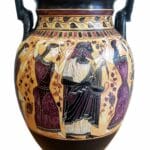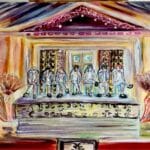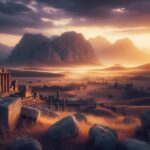This guide explores the fascinating intersection of art, mythology, and modern spectacle, tracing the legacy of Dionysian feasts from classical masterpieces to the 2024 Paris Olympics.
Divine Dinners & Modern Mayhem: Exploring the Dionysian Feast
The Dionysian feast, a scene of divine revelry and unrestrained celebration, has captivated artists for centuries. This guide delves into the evolution of this theme, from its ancient roots to its controversial resurgence on the modern stage.
A Legacy of Legendary Celebrations: The Art of the Dionysian Feast
Dionysian feasts in art offer a glimpse into a world where the boundaries between gods and mortals blur. These vibrant depictions of music, dance, and wine-fueled revelry probably suggest ancient celebrations of pure joy, tinged with a dash of divine danger.
Van Bijlert’s “Feast of the Gods”: Olympus Unveiled
Jan van Bijlert’s “The Feast of the Gods,” housed in the Musée Magnin in Dijon, France, encapsulates the spirit of these mythical gatherings. The painting portrays the wedding feast of Thetis and Peleus on Mount Olympus, a scene teeming with deities. Dionysus, the god of wine and ecstasy, likely holds a prominent place among the revelers, radiating an infectious energy. Some scholars suggest the painting drew inspiration from other artworks depicting similar mythological scenes, adding another layer to its rich history. For more on mythological art, explore Canova’s “Cupid and Psyche.” cupid and psyche canova
Paris 2024: Ancient Myths on the Modern Stage
The opening ceremony of the 2024 Paris Olympics featured a tableau reminiscent of both van Bijlert’s painting and Da Vinci’s “Last Supper.” This echo of classical art sparked debate, with some praising the bold artistic choice, while others questioned the appropriateness of appropriating imagery associated with excess. Thomas Jolly, the ceremony’s artistic director, insisted the scene was not a reference to the Last Supper, despite public interpretations. This incident demonstrates the complex relationship between ancient themes and modern sensitivities, highlighting the potential for misinterpretation and unintended consequences.
Decoding Dionysus: Beyond the Party Animal
Dionysus, the Greek god of wine, embodies the duality of joy and madness, the power of nature, and the ecstatic blurring of boundaries. His feasts, believed to be moments of profound connection between mortals and the divine, are rich in symbolism. Grapes, wine goblets, musical instruments, satyrs, and maenads (Dionysus’s devoted followers) add layers of meaning, inviting us to explore the complex world of ancient beliefs and rituals.
The Feast Continues: Modern Interpretations
Contemporary artists continue to draw inspiration from the Dionysian myth, reinterpreting it through a modern lens. This ongoing engagement suggests the enduring power of mythological narratives and our continued fascination with celebration, excess, and the search for meaning.
Famous Feast Paintings: A Glimpse into Artistic Interpretations
| Artist | Title | Approximate Year | Museum |
|---|---|---|---|
| Jan van Bijlert | The Feast of the Gods | c. 1635-1640 | Musée Magnin, Dijon, France |
| Peter Paul Rubens | Bacchanalia | c. 1630-1635 | Kunsthistorisches Museum, Vienna, Austria |
| Nicolas Poussin | The Bacchanalia | 1624-1625 | Musée du Louvre, Paris, France |
| Diego Velázquez | The Triumph of Bacchus | 1628-1629 | Museo del Prado, Madrid, Spain |
| Francisco Goya | The Bacchanal | 1821-1823 | Museo del Prado, Madrid, Spain |
Ongoing research continues to enrich our understanding of these works and their cultural contexts. The dynamic nature of art history suggests that new interpretations and discoveries are always possible.
Who Painted the Feast of Dionysus? Unraveling Artistic Depictions
The search for a definitive “Feast of Dionysus” painting leads to a collection of artworks representing Dionysian themes. Van Bijlert’s “Feast of the Gods,” while not solely focused on Dionysus, portrays him within the broader context of an Olympian gathering. Caravaggio’s “Bacchus” offers a more intimate portrayal, depicting the god in a relaxed pose surrounded by symbols of his domain. These varied interpretations highlight the multifaceted nature of Dionysian imagery in art. For another captivating historical exploration, dive into the world of the “Douglas TBD Devastator.” douglas tbd devastator
| Painting Title | Artist | Subject |
|---|---|---|
| Feast of the Gods | Jan van Bijlert | Wedding feast of Thetis and Peleus on Olympus |
| Bacchus | Michelangelo Merisi da Caravaggio | Dionysus/Bacchus in a relaxed pose |
Further research into Dionysian art and ancient Greek festivals can deepen understanding of this rich and complex subject. Our knowledge of these ancient practices continues to evolve, suggesting that new discoveries may reshape our current interpretations.
Unmasking Dionysus: The Meaning Behind the Revelry
Dionysian feasts were more than just celebrations; they were deeply ingrained in ancient Greek society, blending religious ritual, artistic expression, and communal bonding.
Exploring the Rites and Rituals
Several key festivals honored Dionysus, each with its own unique character:
The Rural Dionysia: Celebrated in rural communities, these early festivals featured processions, often incorporating symbols of fertility, and culminated in uninhibited revelry.
City Dionysia: A major cultural event in Athens, the City Dionysia showcased theatrical competitions, exploring profound themes through tragedy and comedy. Some scholars suggest these performances emerged from earlier ritualistic practices.
Lenaia: Held during winter, the Lenaia focused primarily on comedic plays, providing a much-needed dose of laughter during the darker months.
Anthesteria: A three-day festival marking the opening of new wine, the Anthesteria blended celebration with rituals related to ancestor worship and purification.
These diverse festivals served multiple purposes – giving thanks for the land’s bounty, exploring the human condition through art, and connecting with the divine. They likely also acted as a social release valve, offering a sanctioned space for uninhibited expression. While our understanding is constantly evolving, it is probable that the feasts of Dionysus held profound cultural and spiritual significance for the ancient Greeks.
Locating the Feast of the Gods: Van Bijlert’s Masterpiece in Dijon
Jan van Bijlert’s The Feast of the Gods resides in the Musée Magnin, Dijon, France. This Dutch Baroque painting, dating from 1635-1640, depicts the mythical wedding feast of Thetis and Peleus, a scene teeming with Olympian deities, including Dionysus. The Musée Magnin, a beautifully preserved mansion, provides a fitting setting for this masterpiece. The painting’s unexpected connection to the 2024 Paris Olympics opening ceremony thrust it into the international spotlight, sparking renewed interest in its history and symbolism.
| Detail | Information |
|---|---|
| Painting Title | The Feast of the Gods |
| Artist | Jan van Bijlert |
| Artistic Style | Dutch Baroque |
| Date Created | c. 1635-1640 |
| Current Location | Musée Magnin, Dijon, France |
| Subject | Wedding Feast of Thetis and Peleus |
| Prominent Figure | Dionysus (God of Wine and Revelry) |
Visiting the Musée Magnin offers a unique opportunity to connect with this captivating artwork and the enduring power of mythology. While our understanding of the painting’s influences and historical context continues to evolve, its enduring appeal remains undeniable.

















2 thoughts on “The Dionysian Feast: From Van Bijlert’s Olympus to the Paris Olympics Stage”
Comments are closed.